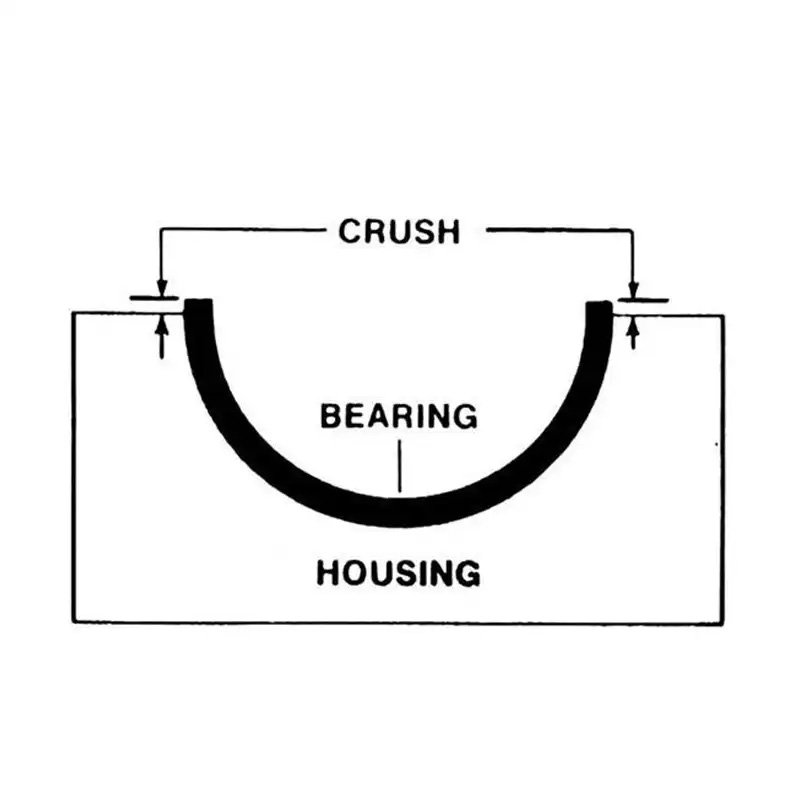Bearings are the unsung heroes of machinery, silently ensuring smooth operations across various industries. In the intricate world of machinery, understanding the nuances of components like bearings is crucial. One such aspect that often raises questions is “bearing crush.”
In this article, we’ll dive into the depths of what bearing crush is and why it matters in the realm of machinery and engineering.
Bearing Crush Definition
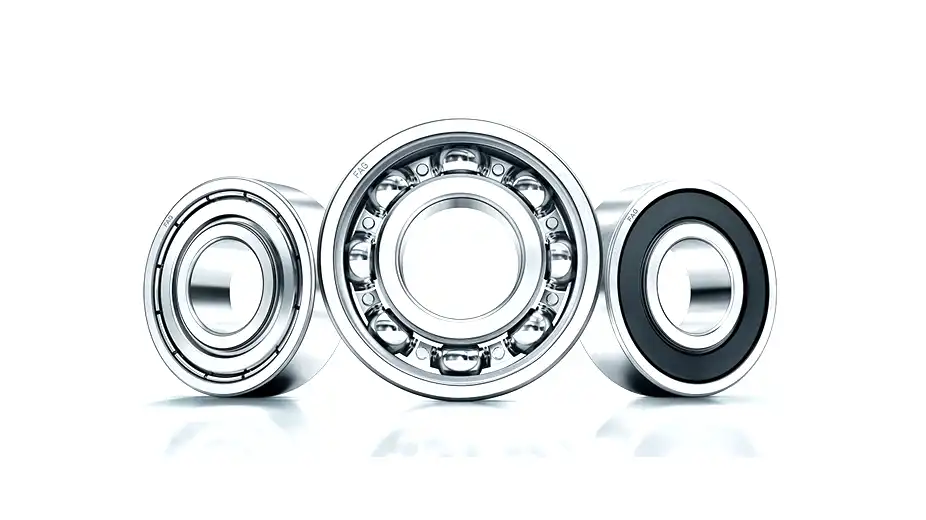
Before we dive into the specifics of bearing crush, it’s essential to establish a foundational understanding of what bearings are and why they are indispensable.
The bearing crush is the intentional deformation or reduction in the outside diameter of the bearing, when you install it in an engine or machinery.
The reduction in diameter can create a compressive force on the bearing, which helps secure it in the right place and ensures proper functioning.
The housing of a bearing is usually made with a slightly smaller diameter than the outer diameter of the bearing when the bearing is fitted into it. The bearing experiences a regulated degree of distortion or reduction in its outer diameter when it is forced into the housing. The purposeful reduction is referred to as bearing crush.
Bearing Crush Purpose
In order to accomplish several crucial goals, bearing crush is used to provide a regulated interference fit between the bearing and its housing:
Secure Fit: The bearing is held firmly in its housing thanks to bearing crush. When the bearing is placed, the deliberate reduction in its outer diameter produces a compressive force that keeps it from rotating or sliding inside the housing while it is in use.
Movement Prevention: The bearing is unable to move either axially or radially due to the interference fit that the bearing crush creates. This is necessary to keep the bearing in its appropriate alignment and orientation, which is necessary for the machinery to operate efficiently.
Load Distribution: The bearing’s controlled deformation through crush aids in creating enough contact between the mating surfaces and the bearing. Ensuring that loads are dispersed uniformly across the bearing, helps to promote uniform wear and prevent localized stress concentrations.
Heat Dissipation: The thermal conductivity between the bearing and its housing is improved by a tight fit brought about by the bearing crush. As a result, heat generated during operation can be routed away from the bearing, reducing overheating and possible damage. This is crucial for effective heat dissipation.
Vibration Damping: Another factor that helps to reduce vibrations in a system is the interference fit that bearing crush provides. This is important because it lowers the possibility of excessive vibration, noise, and even harm to the bearing and nearby components.
Different Types of Bearings
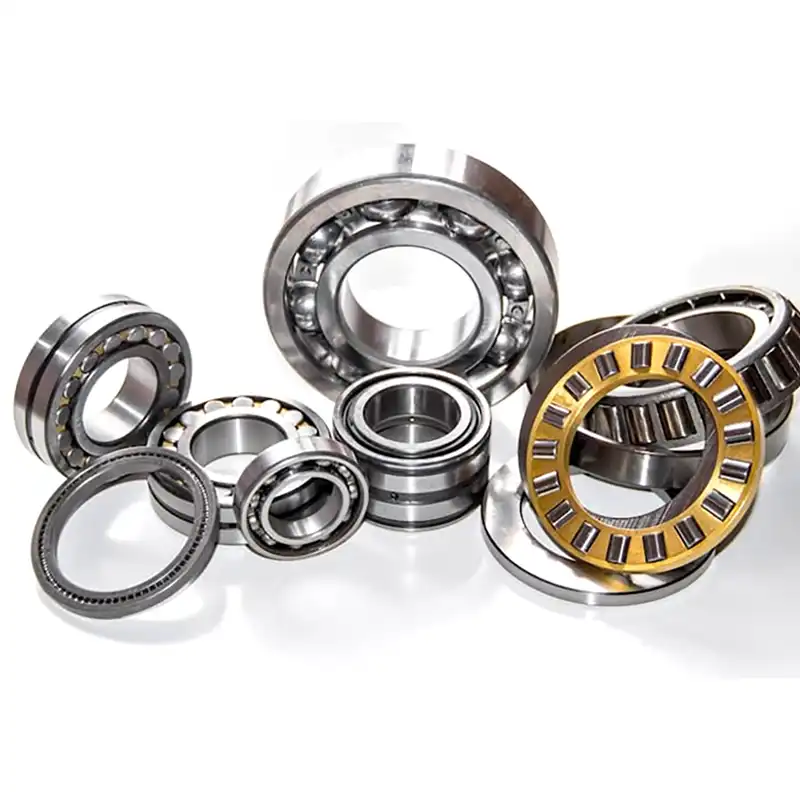
Understanding the nuances of each bearing type is crucial for selecting the right one for a particular application.
Ball bearings, featuring rolling balls between two rings, are ideal for handling radial and thrust loads. Roller bearings, on the other hand, use cylindrical or tapered rollers for enhanced load capacity. Plain bearings, also known as bushings, provide a sliding surface rather than rolling elements and are often used in applications with slower rotational speeds.
The Role of Bearing Crush
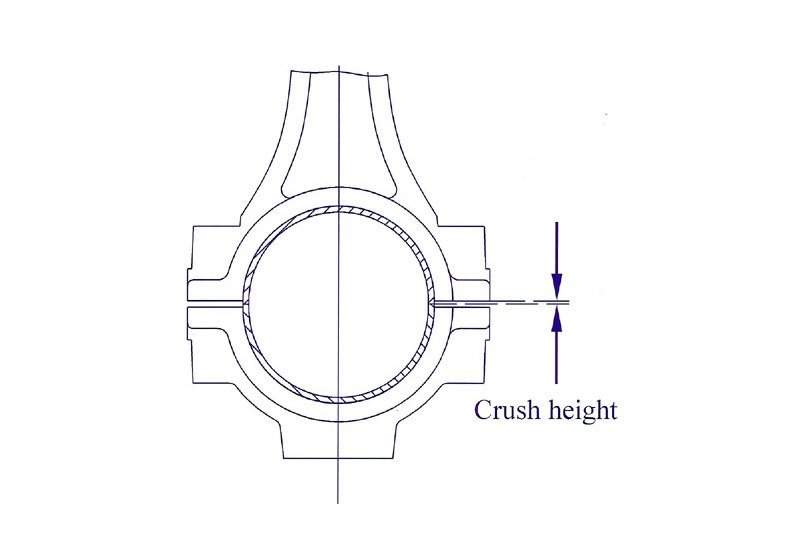
Bearing crush, though it might sound like a technical term, plays a crucial role in the performance and reliability of bearings within machinery.
Let’s unravel the significance of bearing crush and why it’s more than just a small detail in the intricate world of mechanical components.
Explanation of Bearing Crush
At its core, bearing crush refers to the intentional deformation that occurs when a bearing is installed between two mating components. This slight deformation ensures a tight fit between the bearing and its housing. It’s not about damaging the bearing but rather about creating a controlled and necessary amount of interference. This intentional deformation might seem counterintuitive, but it serves a vital purpose in the grand scheme of machinery.
Bearing Crush Check
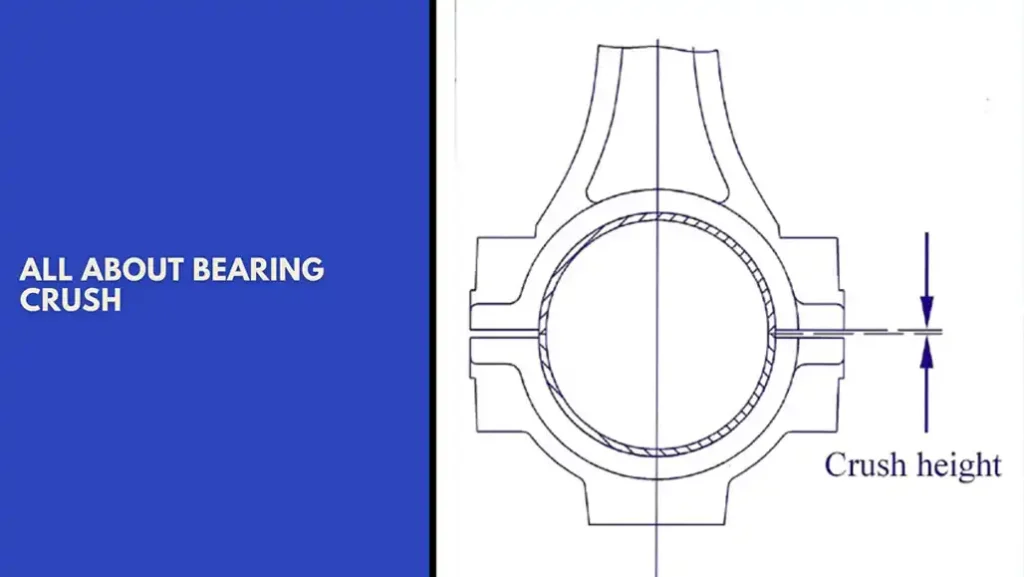
Bearing crush check is a crucial step in the assembly and quality control process for mechanical components that involve bearings. It involves verifying whether the bearing has undergone the intended deformation or reduction in outer diameter, commonly known as bearing crush, when installed in its housing.
The process typically involves measuring the outer diameter of the bearing after it has been installed in the housing. This measured diameter is then compared to the specified design or tolerance values. The difference between the original outer diameter of the bearing and the measured outer diameter after installation indicates the amount of bearing crush achieved.
If the bearing crush is within the specified tolerances, it indicates that the bearing has been properly installed, and the desired interference fit has been established. This ensures that the bearing will be securely held in place, preventing movement and maintaining proper alignment during operation.
On the other hand, if the measured outer diameter deviates significantly from the design values, it may indicate a problem with the installation process or potential issues with the bearing or housing dimensions. In such cases, corrective actions may be necessary to ensure the proper functioning and longevity of the bearing within the machinery or assembly.
Bearing crush checks are essential for quality control and to ensure that the assembled components meet the required specifications for secure fit, load distribution, heat dissipation, and vibration damping.
Bearing Crush Height Measurement

Bearing crush height measurement is a critical step in the process of installing engine bearings. The term “bearing crush” refers to the intentional deformation or reduction in the outside diameter of the bearing when it is installed into its housing. This deformation creates an interference fit between the bearing and its housing, ensuring a secure and precise fit.
Measuring the bearing crush height is essential to confirm that the proper interference fit has been achieved. Here’s a step-by-step guide on how to measure bearing crush height:
Select the Right Tools:
Micrometer or dial bore gauge: These tools are used to measure the inside diameter of the bearing.
Depth micrometer or gauge: Necessary for measuring the height of the bearing crush.
Calipers: To measure the outside diameter of the bearing.
Prepare the Bearing and Housing:
Ensure that both the bearing and its housing are clean and free of any debris or contaminants.
Lubricate the bearing with oil before installation to facilitate proper seating.
Install the Bearing:
Carefully place the bearing into its housing, making sure it is seated correctly.
Measure the Inside Diameter:
Use a micrometer or dial bore gauge to measure the inside diameter of the bearing. Take measurements at multiple points around the circumference to ensure accuracy.
Measure the Outside Diameter:
Use calipers to measure the outside diameter of the bearing. Again, take measurements at multiple points to ensure accuracy.
Calculate Bearing Crush:
Subtract the measured inside diameter from the measured outside diameter. The result is the amount of deformation or reduction in the bearing’s diameter, known as the bearing crush.
Measure Crush Height:
Use a depth micrometer or gauge to measure the height of the bearing crush. This is the distance between the parting lines of the bearing when it’s installed and when it’s not.
Compare to Specifications:
Refer to the engine manufacturer’s specifications or guidelines to ensure that the measured bearing crush height falls within the recommended range. Each engine may have different requirements, so it’s crucial to follow the specifications provided.
Adjust if Necessary:
If the measured bearing crush height is outside the specified range, adjustments may be needed. This could involve selecting a different set of bearings with the appropriate crush height or making other modifications as recommended by the engine manufacturer.
Proper measurement and control of the bearing crush height are essential for maintaining the integrity and performance of engine bearings, contributing to the overall reliability and longevity of the engine.
Factors Influencing Bearing Crush
Understanding the nuanced factors that influence bearing crush is essential for appreciating its role in the overall performance of machinery. Let’s take a deeper look at each factor and its impact on achieving the right amount of intentional deformation in bearings.
Surface Finish of Mating Components
Imagine the surfaces where the bearing sits as a puzzle – the pieces need to fit together seamlessly. The surface finish of these components is like the texture of the puzzle pieces. A rough or uneven surface can hinder the proper seating of the bearing, leading to challenges in achieving the desired crush. Precision machining ensures that these surfaces are not only smooth but also perfectly aligned, creating an environment conducive to the controlled deformation necessary for optimal bearing crush.
Material Characteristics
Just as different puzzle pieces are made of various materials, the materials chosen for the bearing and its housing components are critical. They must complement each other in terms of hardness, durability, and resistance to factors like corrosion and wear. The goal is to ensure that the materials can withstand the dynamic forces and conditions during operation without compromising the effectiveness of the bearing crush. Compatibility between materials is key to preventing premature failures and maintaining the integrity of the bearing.
Precision in Assembly
The assembly process is where all the puzzle pieces come together. Precision in this phase is akin to the finesse required to complete the puzzle successfully. Each step, from aligning the components to applying the right amount of force during installation, contributes to achieving the desired bearing crush. Following manufacturer guidelines and industry standards becomes crucial here. Deviations from recommended procedures can result in variations in crush, impacting the stability and performance of the bearing.
Consider the assembly process as a delicate dance – too little force, and the bearing might not seat properly, too much force, and it risks over-deformation. Achieving the delicate balance requires expertise and adherence to best practices.
In essence, the surface finish, material characteristics, and precision in assembly are interconnected elements in the intricate dance of bearing crush. Manufacturers and technicians must navigate these factors with finesse to ensure that the bearing crush is not just a checkbox but a calculated and intentional step towards enhancing machinery performance and reliability.
Importance of Optimal Bearing Crush
Optimal bearing crush is a critical factor in ensuring the proper functioning and longevity of engine bearings in internal combustion engines. Bearings are crucial components that support rotating shafts within the engine, such as crankshafts and camshafts. The term “bearing crush” refers to the interference fit between the bearing and its housing in the engine.
Here are some key points highlighting the importance of optimal bearing crush:
Load Distribution: The primary function of engine bearings is to support and distribute the loads generated by the rotating shafts. Optimal bearing crush ensures that the bearing is securely seated in its housing, allowing for proper load distribution. This is crucial for preventing metal-to-metal contact and reducing wear on both the bearing and the shaft.
Oil Film Thickness: Bearings rely on a thin film of oil between the bearing surface and the shaft to prevent direct metal-to-metal contact. The correct amount of bearing crush helps in maintaining the proper oil film thickness. Too little crush can result in insufficient oil film thickness, leading to increased friction and wear, while excessive crush may cause oil starvation due to reduced clearance.
Vibration and Noise Control: Adequate bearing crush helps in damping vibrations and minimizing noise within the engine. When the bearing is securely fitted, it reduces the chances of excessive movement or play, contributing to a smoother and quieter engine operation.
Heat Dissipation: Engine bearings are exposed to significant heat generated during combustion. Optimal crush aids in proper heat dissipation by facilitating efficient transfer of heat away from the bearing surface. This is crucial for preventing overheating and maintaining the structural integrity of the bearing material.
Sealing: The correct bearing crush assists in forming a proper seal between the bearing and its housing. This is essential for preventing the leakage of oil and maintaining a closed system for lubrication. Effective sealing ensures that the lubricating oil stays within the bearing, promoting consistent and reliable lubrication.
Engine Performance and Efficiency: The overall performance and efficiency of an engine are directly influenced by the proper functioning of its components, including bearings. Optimal bearing crush contributes to reduced friction, enhanced reliability, and improved overall efficiency of the engine.
In summary, achieving and maintaining optimal bearing crush is crucial for the proper operation, durability, and efficiency of internal combustion engines. It ensures proper load distribution, lubrication, heat dissipation, and overall performance, ultimately extending the life of the engine components.
FAQs about Bearing Crush
What is the purpose of bearing crush?
How is bearing crush measured?
What happens if there is insufficient bearing crush?
Can excessive bearing crush cause issues?
Why is precision in the assembly process crucial for bearing crush?
Conclusion
In conclusion, while bearing crush may seem like a minute detail in the grand scheme of machinery, its impact is substantial. It is a critical factor influencing the performance, reliability, and longevity of bearings and, consequently, the machinery they support.
Manufacturers, technicians, and engineers must prioritize precision in assembly and adherence to recommended guidelines to ensure optimal bearing crush. The future promises exciting advancements in bearing technology, further enhancing the efficiency and durability of machinery.

